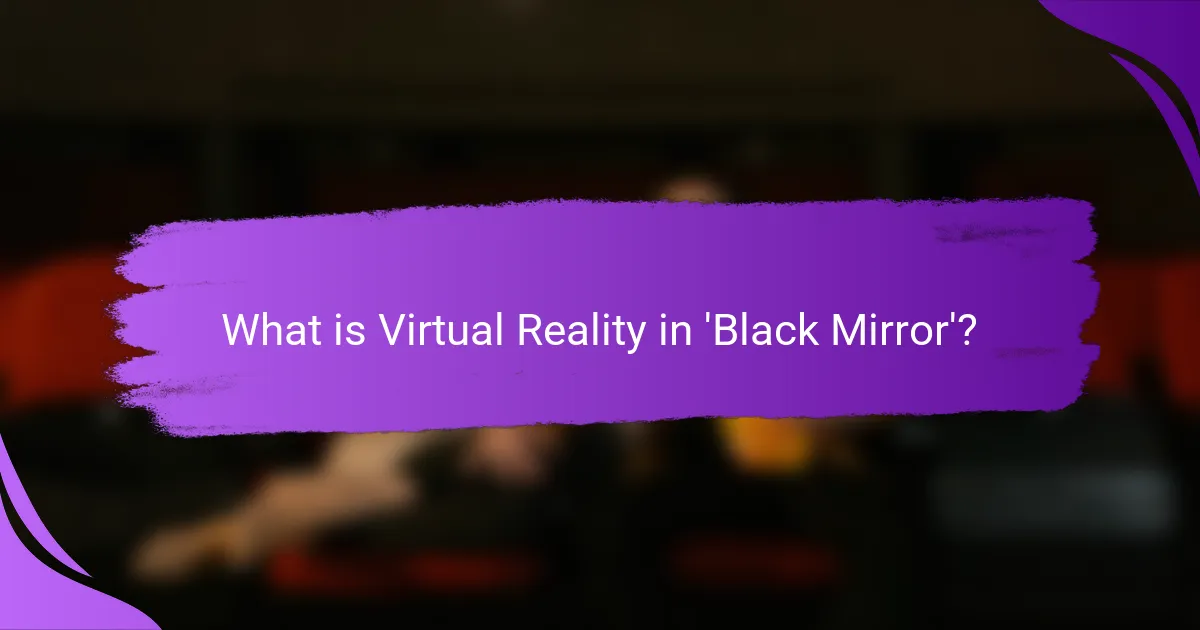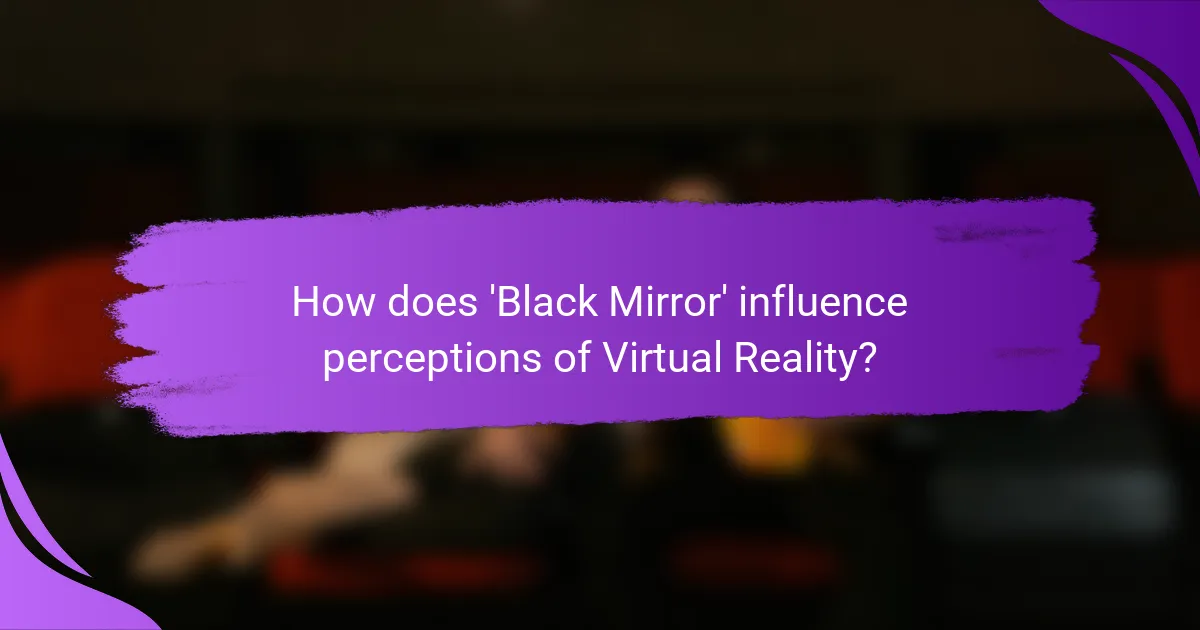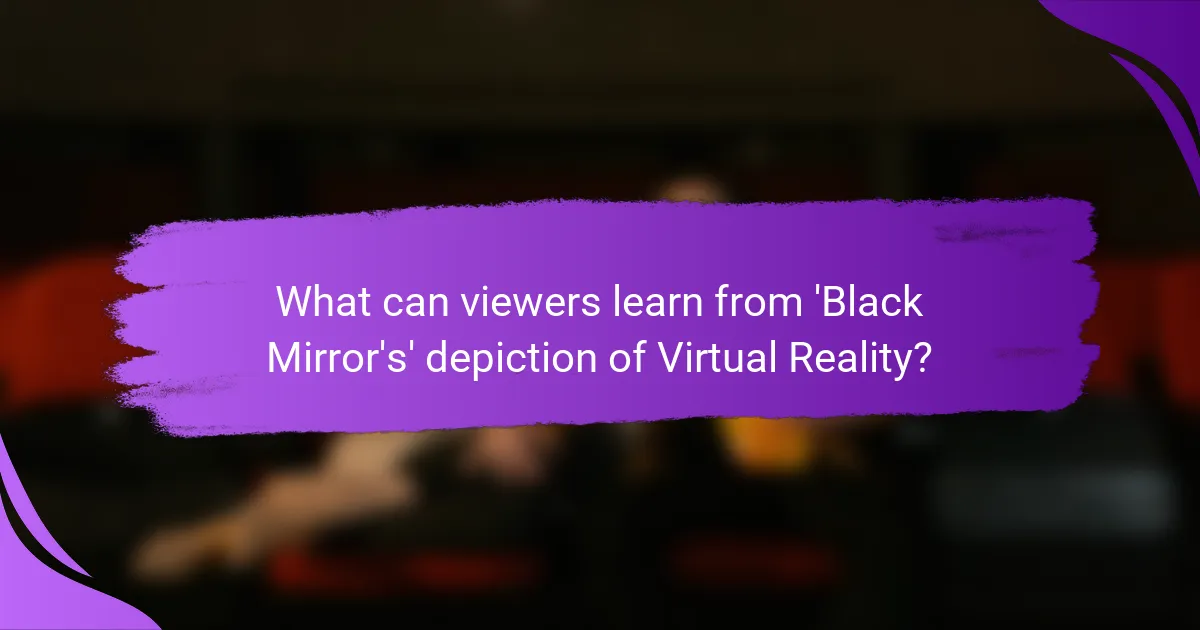The article explores the concept of Virtual Reality as depicted in the television series ‘Black Mirror,’ which presents immersive digital experiences that simulate real-life scenarios. It examines the implications of advanced virtual reality technology on human behavior and society, highlighting episodes such as “San Junipero” and “USS Callister” that illustrate ethical dilemmas, emotional consequences, and the potential for manipulation in virtual environments. The series raises critical questions about the psychological effects of virtual reality, including addiction, loss of identity, and consent. By contrasting the positive and negative aspects of virtual reality, ‘Black Mirror’ encourages viewers to consider the societal impact of emerging technologies and the future of human interaction within virtual spaces.

What is Virtual Reality in ‘Black Mirror’?
Virtual reality in ‘Black Mirror’ refers to immersive digital experiences that simulate real-life scenarios. The series explores the implications of advanced virtual reality technology on human behavior and society. Episodes like “San Junipero” showcase a world where individuals can live in a digital afterlife. In “USS Callister,” virtual reality is used to create a dystopian simulation where characters are trapped. These narratives highlight ethical dilemmas, emotional consequences, and the potential for manipulation within virtual environments. ‘Black Mirror’ serves as a cautionary tale about the intersection of technology and humanity.
How is Virtual Reality portrayed in ‘Black Mirror’?
Virtual reality in ‘Black Mirror’ is portrayed as a complex and often dystopian technology. It explores themes of escapism and the consequences of immersive experiences. Episodes like “San Junipero” depict VR as a means of experiencing alternate realities. In contrast, “Playtest” highlights the dangers of VR when it becomes a tool for psychological manipulation. The series critiques the ethical implications of VR, such as identity and consent. Overall, ‘Black Mirror’ presents virtual reality as a double-edged sword, offering both profound experiences and potential hazards.
What are the key episodes that feature Virtual Reality?
The key episodes that feature Virtual Reality in “Black Mirror” are “San Junipero,” “Playtest,” and “USS Callister.” “San Junipero” explores a virtual afterlife where people can live in a simulated reality. “Playtest” delves into the dangers of immersive gaming and the psychological effects of VR. “USS Callister” presents a twisted take on virtual reality within a space simulation, highlighting themes of control and identity. Each episode showcases unique aspects of virtual reality and its implications on human experience.
How does the narrative utilize Virtual Reality as a plot device?
The narrative utilizes Virtual Reality as a plot device to explore complex human experiences and ethical dilemmas. In ‘Black Mirror,’ VR immerses characters in alternate realities that reflect their desires and fears. This immersion creates intense emotional responses, allowing viewers to engage deeply with the story. Episodes like “San Junipero” exemplify this by juxtaposing a digital afterlife with real-life consequences. The VR environment serves as a catalyst for character development and moral questions. It challenges perceptions of reality and the implications of technology on relationships. This use of VR enhances storytelling by making abstract themes tangible and relatable.
What innovations in Virtual Reality are showcased in ‘Black Mirror’?
‘Black Mirror’ showcases several innovations in Virtual Reality, particularly in episodes like “San Junipero” and “USS Callister.” In “San Junipero,” the concept of uploading consciousness to a virtual paradise is explored. This allows individuals to live indefinitely in a simulated environment. The episode highlights emotional connections and experiences within a virtual world. “USS Callister” presents a VR game where players’ personalities are replicated. This raises ethical questions about consent and autonomy in virtual spaces. These narratives illustrate the potential and risks of advanced VR technologies. They provoke thought on the implications of immersive experiences on human identity and relationships.
How do these innovations reflect current technological trends?
Innovations in virtual reality as depicted in ‘Black Mirror’ reflect current technological trends by showcasing advancements in immersive experiences. These innovations highlight the integration of artificial intelligence and machine learning in user interactions. They also emphasize the growing importance of social connectivity in virtual spaces. The series illustrates how virtual reality can enhance emotional engagement through realistic simulations. Furthermore, the portrayal of ethical dilemmas in technology aligns with contemporary discussions on privacy and data security. Overall, ‘Black Mirror’ serves as a commentary on the potential consequences of rapidly evolving technologies.
What unique features set ‘Black Mirror’s’ Virtual Reality apart from real-world applications?
‘Black Mirror’s’ Virtual Reality features immersive experiences that often blur the line between reality and simulation. These experiences include extreme emotional manipulation and ethical dilemmas not typically present in real-world applications. For instance, the episode “San Junipero” showcases a virtual afterlife that raises questions about consciousness and identity. Additionally, the series often presents technology’s darker implications, such as loss of autonomy and psychological distress. In contrast, real-world VR applications focus more on entertainment, training, and therapeutic uses without such intense moral complexities. The unique narrative-driven approach in ‘Black Mirror’ emphasizes speculative scenarios that provoke thought about future technological impacts.
What experiences do characters undergo in ‘Black Mirror’s’ Virtual Reality?
Characters in ‘Black Mirror’s’ Virtual Reality undergo intense and often disturbing experiences. They face scenarios that challenge their perceptions of reality and morality. For example, in “San Junipero,” characters live alternate lives in a digital afterlife. In “Playtest,” a character confronts personal fears through a horror game that blurs reality. Characters often experience emotional turmoil, such as loss or betrayal. The virtual environments are designed to evoke strong psychological responses. These experiences highlight the potential consequences of advanced technology on human emotions and relationships. Each episode illustrates different facets of virtual reality’s impact on identity and choice.
How do these experiences impact character development?
Experiences in virtual reality significantly impact character development by providing immersive scenarios that challenge individuals. These scenarios often force characters to confront their fears, desires, and ethical dilemmas. In ‘Black Mirror’, characters undergo transformations due to the consequences of their virtual choices. For instance, the episode “USS Callister” illustrates how power dynamics shift in virtual environments, leading to profound personal changes. Research indicates that immersive experiences can enhance empathy and self-awareness, crucial components of character growth. A study by K. Bailenson at Stanford University shows that virtual experiences can alter real-world attitudes and behaviors. Such findings validate the claim that virtual reality experiences shape character development in meaningful ways.
What ethical dilemmas arise from Virtual Reality experiences in the series?
Ethical dilemmas in Virtual Reality experiences in ‘Black Mirror’ include issues of consent, identity, and psychological impact. Characters often engage in VR without fully understanding the consequences. Consent becomes problematic when users are manipulated or coerced into experiences. Identity issues arise as individuals can assume different personas, blurring reality and self-perception. Psychological impacts include desensitization and emotional trauma from immersive experiences. These dilemmas challenge viewers to consider the moral implications of advanced technology in their lives.

How does ‘Black Mirror’ influence perceptions of Virtual Reality?
‘Black Mirror’ influences perceptions of Virtual Reality by presenting dystopian scenarios that highlight both its potential and dangers. The series explores how immersive technology can manipulate human experiences and relationships. Episodes like “San Junipero” portray Virtual Reality as a means of escape and connection, while “Playtest” showcases its darker implications, such as fear and loss of control. These contrasting narratives shape viewers’ understanding of Virtual Reality’s ethical and psychological consequences. The show’s critical reception emphasizes the importance of considering the societal impact of emerging technologies. By examining these themes, ‘Black Mirror’ encourages audiences to reflect on the future of Virtual Reality and its role in human life.
What societal issues does ‘Black Mirror’ highlight through its Virtual Reality themes?
‘Black Mirror’ highlights societal issues such as addiction to technology and the loss of human connection through its Virtual Reality themes. The series showcases characters who become immersed in virtual worlds, often at the expense of their real-life relationships. This reflects concerns about how technology can lead to isolation. The show also addresses ethical dilemmas, such as the implications of identity manipulation and consent in virtual environments. In episodes like “Playtest,” the dangers of unchecked technological advancement are portrayed, emphasizing the potential for psychological harm. Additionally, ‘Black Mirror’ critiques consumerism by showing how virtual experiences can be commodified, leading to exploitation. Overall, the series serves as a cautionary tale about the consequences of our increasing reliance on virtual realities.
How does the series provoke discussions about technology and humanity?
The series “Black Mirror” provokes discussions about technology and humanity by exploring the ethical implications of advanced technologies. Each episode presents a unique scenario that reflects potential future realities. These scenarios often highlight the consequences of human behavior in relation to technology. For example, the episode “San Junipero” examines the intersection of virtual reality and consciousness. It raises questions about identity, memory, and the essence of being human. The series also critiques society’s reliance on technology, as seen in “Nosedive,” which portrays a world governed by social media ratings. This commentary encourages viewers to reflect on their own relationships with technology. Overall, “Black Mirror” serves as a cautionary tale, prompting critical conversations about the balance between innovation and ethical considerations.
How does ‘Black Mirror’ shape the future possibilities of Virtual Reality?
‘Black Mirror’ shapes future possibilities of Virtual Reality by exploring its ethical implications and societal impacts. The series presents scenarios where VR technology alters human experiences and relationships. Episodes like “San Junipero” and “USS Callister” depict immersive environments that enhance emotional connections. These narratives provoke discussions about identity, consent, and reality perception. The show highlights potential dangers, such as addiction and loss of autonomy. By showcasing both positive and negative outcomes, ‘Black Mirror’ encourages viewers to consider responsible VR development. The series serves as a cautionary tale, urging creators to prioritize ethical considerations in VR advancements.
What predictions can be made about the evolution of Virtual Reality based on the series?
The series “Black Mirror” predicts that Virtual Reality will evolve to become increasingly immersive and indistinguishable from reality. This evolution will likely lead to enhanced emotional experiences, as depicted in episodes like “San Junipero.” The show illustrates the potential for VR to create deep connections between users. Furthermore, advancements in technology could enable users to experience memories and emotions in a more profound way. The series also suggests that ethical dilemmas will arise as VR blurs the lines between real and virtual lives. As VR technology progresses, issues related to addiction and escapism may become more prevalent. Overall, “Black Mirror” presents a cautionary view of VR’s future, highlighting both its transformative potential and inherent risks.
How might ‘Black Mirror’s’ portrayal of Virtual Reality inspire real-world innovations?
‘Black Mirror’s’ portrayal of Virtual Reality can inspire real-world innovations by highlighting ethical dilemmas and technological possibilities. The series presents scenarios where VR enhances human experience, pushing boundaries of entertainment and interaction. For instance, episodes like “San Junipero” showcase immersive environments that can evoke deep emotional responses. This demonstrates the potential for VR in therapy and mental health treatment. The show also raises questions about privacy and consent in virtual spaces. Such discussions can drive developers to create safer, more ethical VR experiences. Furthermore, the imaginative technologies depicted can spark ideas for new applications in various industries, including education and training. Overall, ‘Black Mirror’ serves as a catalyst for exploring both the benefits and challenges of VR in society.

What can viewers learn from ‘Black Mirror’s’ depiction of Virtual Reality?
Viewers can learn about the ethical implications and psychological effects of Virtual Reality from ‘Black Mirror’. The series illustrates how immersive technology can alter human experience and perception. Episodes like “Playtest” show the dangers of blurring reality and virtual experiences. They highlight potential addiction and the loss of personal identity. Additionally, the show raises questions about consent and manipulation in virtual environments. By presenting dystopian scenarios, ‘Black Mirror’ encourages critical thinking about the future of technology. It emphasizes the need for responsible development and usage of Virtual Reality.
What are the potential risks associated with Virtual Reality as depicted in ‘Black Mirror’?
The potential risks associated with Virtual Reality in ‘Black Mirror’ include psychological trauma, addiction, and loss of reality. Psychological trauma can occur when users experience intense emotional situations without real-world consequences. Addiction is depicted through characters becoming unable to distinguish between virtual experiences and their actual lives. Loss of reality happens when users become so immersed in VR that they neglect their real-world responsibilities and relationships. These themes illustrate the darker implications of VR technology as explored in the series.
How can audiences apply these lessons to real-world Virtual Reality applications?
Audiences can apply lessons from “Black Mirror” to real-world Virtual Reality applications by recognizing the ethical implications of immersive technology. For instance, they can evaluate how VR influences human behavior and societal norms. This reflection can guide developers in creating responsible VR experiences. Moreover, audiences can analyze narrative techniques used in the series to enhance storytelling in VR. By understanding character motivations and plot twists, creators can craft more engaging and impactful narratives. Additionally, lessons on user experience design can inform the development of intuitive interfaces. This ensures that users can easily navigate VR environments. Real-world applications can also benefit from the exploration of psychological effects shown in the series. Understanding these effects can help in developing VR therapies or training programs. Overall, audiences can leverage these lessons to foster innovation while prioritizing ethical considerations in VR development.
What are best practices for engaging with Virtual Reality technology today?
To engage effectively with Virtual Reality technology today, users should prioritize safety and comfort. Begin by ensuring a clear play area free from obstacles. This minimizes the risk of accidents while immersed in VR experiences. Users should also take regular breaks to prevent discomfort and motion sickness, as prolonged use can lead to fatigue.
It’s crucial to adjust headset settings for optimal clarity and comfort. This includes calibrating the interpupillary distance and adjusting the fit of the headset. Engaging with high-quality content enhances the experience. Seek out well-reviewed applications and games designed for VR.
Additionally, users should explore social VR platforms to foster connections with others. This can enhance the overall experience and provide a sense of community. Lastly, keeping software updated ensures access to the latest features and security improvements. Following these practices can significantly enhance the enjoyment and safety of engaging with Virtual Reality technology.
How can users ensure a positive and safe experience in Virtual Reality environments?
Users can ensure a positive and safe experience in Virtual Reality environments by following several guidelines. First, they should familiarize themselves with the VR system and its controls. Understanding how to navigate the environment reduces confusion and enhances enjoyment.
Second, users should create a safe physical space free from obstacles. This minimizes the risk of injury while immersed in VR. Third, they should take regular breaks to prevent discomfort and motion sickness. Studies indicate that prolonged use can lead to negative physical effects.
Fourth, users must adjust settings for comfort. This includes calibrating visual settings and ensuring the headset fits properly. Lastly, users should be aware of their surroundings while using VR. This awareness helps prevent accidents and enhances the overall experience.
Virtual Reality in ‘Black Mirror’ serves as a critical exploration of immersive technology and its impact on human behavior and society. The series showcases key episodes like “San Junipero,” “Playtest,” and “USS Callister,” which delve into themes of escapism, ethical dilemmas, and psychological manipulation. It highlights innovations in VR, reflecting current technological trends while presenting unique features that distinguish its narrative from real-world applications. The article discusses character experiences, societal issues, and the potential risks associated with VR, ultimately provoking discussions about the future of technology and its implications for humanity.